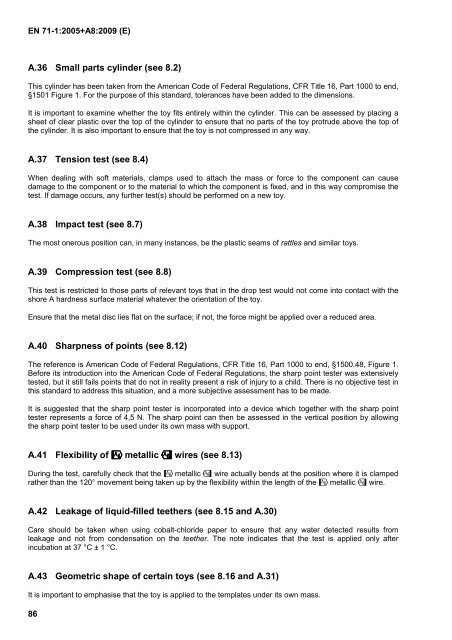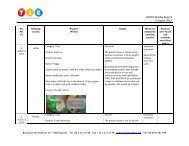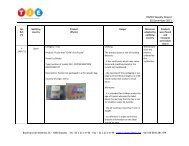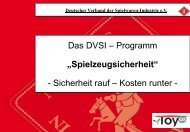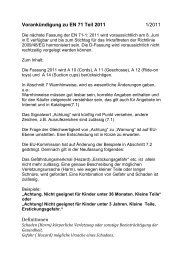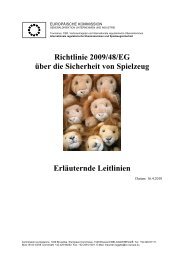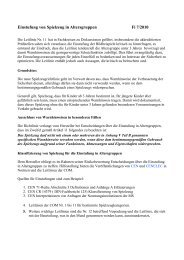Create successful ePaper yourself
Turn your PDF publications into a flip-book with our unique Google optimized e-Paper software.
<strong>EN</strong> <strong>71</strong>-1:<strong>2005+</strong><strong>A8</strong>:2009 (E)<br />
A.36 Small parts cylinder (see 8.2)<br />
This cylinder has been taken from the American Code of Federal Regulations, CFR Title 16, Part 1000 to end,<br />
§1501 Figure 1. For the purpose of this standard, tolerances have been added to the dimensions.<br />
It is important to examine whether the toy fits entirely within the cylinder. This can be assessed by placing a<br />
sheet of clear plastic over the top of the cylinder to ensure that no parts of the toy protrude above the top of<br />
the cylinder. It is also important to ensure that the toy is not compressed in any way.<br />
A.37 Tension test (see 8.4)<br />
When dealing with soft materials, clamps used to attach the mass or force to the component can cause<br />
damage to the component or to the material to which the component is fixed, and in this way compromise the<br />
test. If damage occurs, any further test(s) should be performed on a new toy.<br />
A.38 Impact test (see 8.7)<br />
The most onerous position can, in many instances, be the plastic seams of rattles and similar toys.<br />
A.39 Compression test (see 8.8)<br />
This test is restricted to those parts of relevant toys that in the drop test would not come into contact with the<br />
shore A hardness surface material whatever the orientation of the toy.<br />
Ensure that the metal disc lies flat on the surface; if not, the force might be applied over a reduced area.<br />
A.40 Sharpness of points (see 8.12)<br />
The reference is American Code of Federal Regulations, CFR Title 16, Part 1000 to end, §1500.48, Figure 1.<br />
Before its introduction into the American Code of Federal Regulations, the sharp point tester was extensively<br />
tested, but it still fails points that do not in reality present a risk of injury to a child. There is no objective test in<br />
this standard to address this situation, and a more subjective assessment has to be made.<br />
It is suggested that the sharp point tester is incorporated into a device which together with the sharp point<br />
tester represents a force of 4,5 N. The sharp point can then be assessed in the vertical position by allowing<br />
the sharp point tester to be used under its own mass with support.<br />
A.41 Flexibility of +metallic, wires (see 8.13)<br />
During the test, carefully check that the +metallic, wire actually bends at the position where it is clamped<br />
rather than the 120° movement being taken up by the flexibility within the length of the +metallic, wire.<br />
A.42 Leakage of liquid-filled teethers (see 8.15 and A.30)<br />
Care should be taken when using cobalt-chloride paper to ensure that any water detected results from<br />
leakage and not from condensation on the teether. The note indicates that the test is applied only after<br />
incubation at 37 °C ± 1 °C.<br />
A.43 Geometric shape of certain toys (see 8.16 and A.31)<br />
It is important to emphasise that the toy is applied to the templates under its own mass.<br />
86


